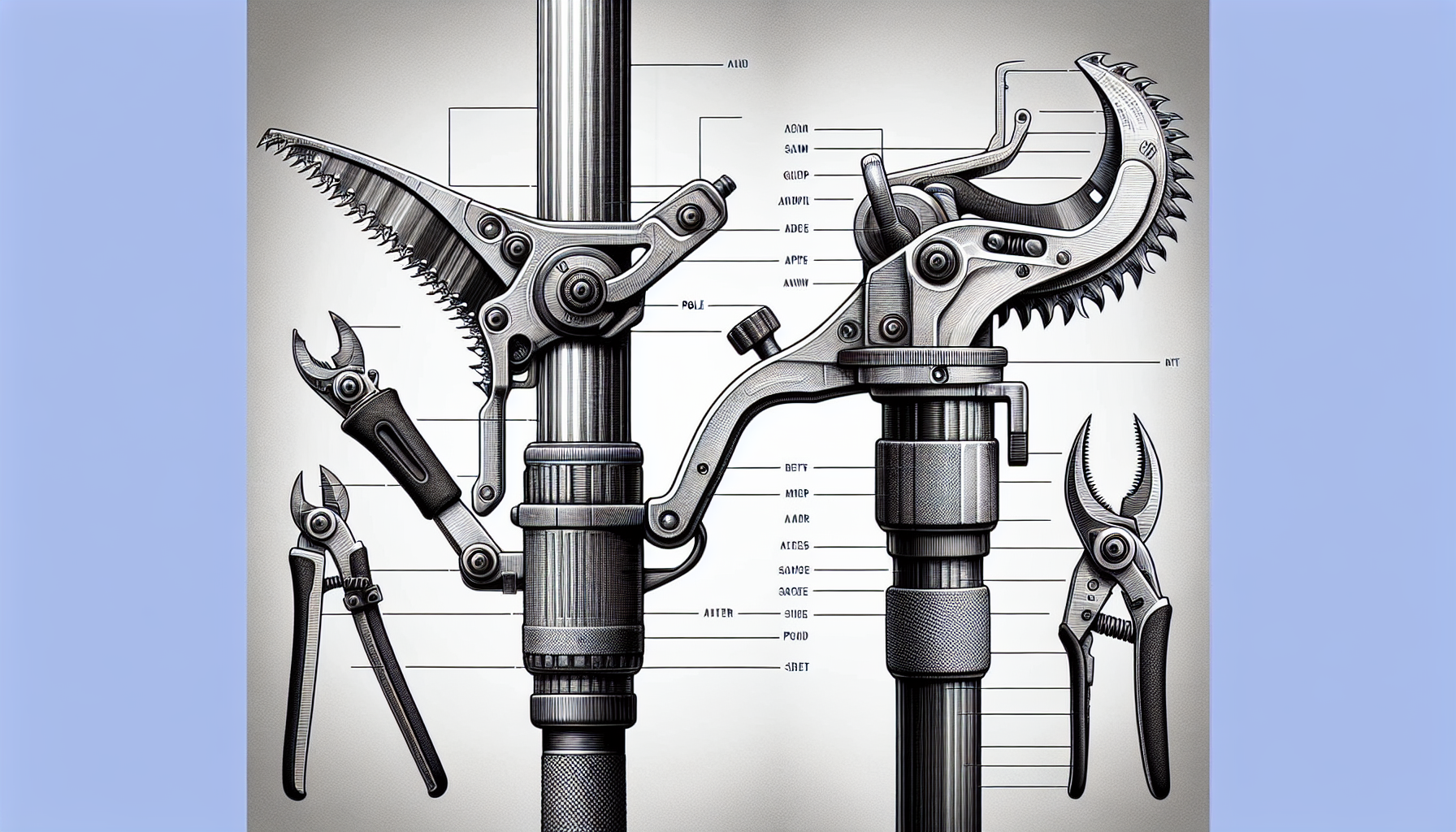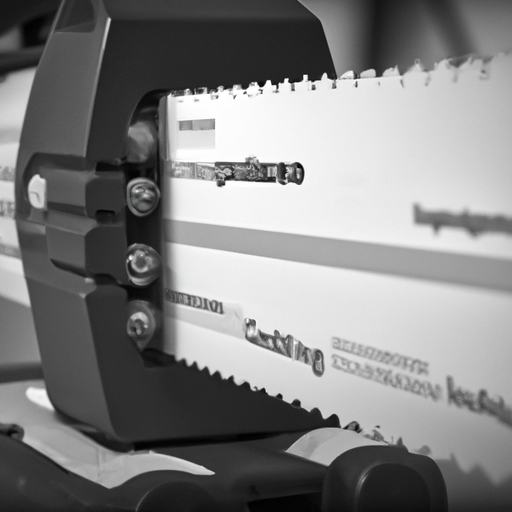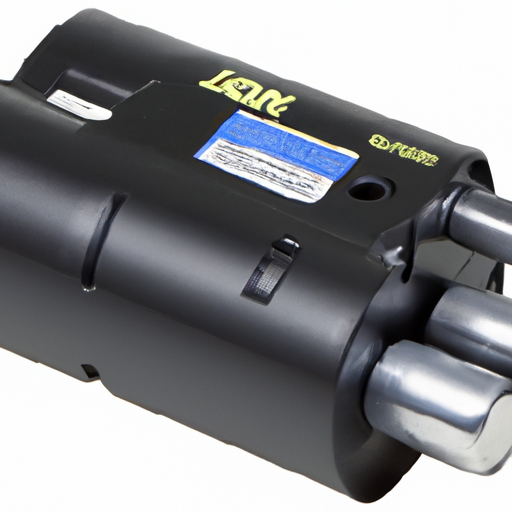Have you ever wondered what sets a pole saw apart from a pole pruner? If so, you’re not alone! Many people get confused between these two gardening tools, but fear not, as we’re here to shed some light on the subject. In this article, we’ll explore the key differences between a pole saw and a pole pruner, helping you to make an informed decision when it comes to tackling those tall branches in your garden. Let’s dive in and discover which tool suits your needs best!
Definition of Pole Saw and Pole Pruner
Pole Saw
A pole saw is a versatile gardening tool that is designed to help you trim and prune tall trees and branches from the ground. It consists of a long pole with a saw blade attached at one end. Using a pole saw allows you to reach high branches without the need for a ladder or climbing the tree, making it safer and more convenient for tree and branch maintenance.
Pole Pruner
A pole pruner, on the other hand, is specifically designed for pruning and cutting smaller branches and stems. It features a long pole with a pruning shear or lopper attached at the end. With a pole pruner, you can easily access and trim branches that are out of reach, making it an essential tool for maintaining the overall health and aesthetics of your trees and plants.
Design and Components
Pole Saw Design
Pole saws are typically designed with a telescopic pole that can be extended to reach high branches. The pole is made from lightweight materials such as aluminum or fiberglass, making it easy to maneuver and control. The saw blade is usually attached at the end of the pole and can be adjusted to various angles for efficient cutting. Some pole saws also feature a non-slip grip handle and a shoulder strap for added comfort during use.
Pole Pruner Design
Pole pruners are designed with a similar telescopic pole that can be extended for reaching branches. The pole is also lightweight and easy to handle. At the end of the pole, instead of a saw blade, there is a pruning shear or lopper. The pruning shear is operated by a lever or rope mechanism that allows you to cut through branches with ease. Some pole pruners come with a rotating head, which gives you more flexibility when trimming branches from different angles.
Components of Pole Saw
A pole saw typically consists of a telescopic pole, a solid grip handle, a saw blade, and an adjustable cutting angle mechanism. The telescopic pole allows you to adjust the length of the pole according to your desired reach. The solid grip handle ensures a firm and comfortable hold, allowing you to exert necessary pressure while cutting. The saw blade is usually made from high-quality steel and can be detachable or foldable for easy storage.
Components of Pole Pruner
A pole pruner is composed of a telescopic pole, a grip handle, a pruning shear or lopper, and a lever or rope mechanism. The telescopic pole can be extended or retracted to achieve the desired reach. The grip handle provides a comfortable and secure grip while operating the pruner. The pruning shear or lopper is designed to cut through branches effortlessly, and the lever or rope mechanism allows you to apply the necessary force to make clean and precise cuts.
Functionality
Pole Saw Functionality
A pole saw is a functional and efficient tool for trimming and cutting high branches. It enables you to reach inaccessible areas without the need to climb trees or use a ladder, making it safer and less physically demanding. With its adjustable cutting angle mechanism, you can easily maneuver the saw blade to cut branches at different angles. Pole saws are ideal for pruning overgrown trees, removing dead branches, and maintaining overall tree health.
Pole Pruner Functionality
The main functionality of a pole pruner is to make precise cuts on smaller branches and stems. It allows you to selectively prune branches for better growth patterns, improved aesthetics, and overall tree health. The grip handle and lever or rope mechanism make it easy to apply the necessary force while cutting branches cleanly. Pole pruners are especially useful for maintaining fruit trees, shrubs, and ornamental plants.
Cutting Mechanism
Pole Saw Cutting Mechanism
Pole saws typically feature a saw blade with sharp teeth that cut through branches using a pulling or pushing motion. The cutting mechanism can vary depending on the type of saw blade, such as a curved blade or a straight blade. The teeth of the saw blade are designed to bite into the wood and remove material efficiently, allowing for smooth and precise cuts. With the adjustable cutting angle mechanism, you can easily position the saw blade for optimal cutting performance.
Pole Pruner Cutting Mechanism
Pole pruners utilize a cutting mechanism that involves the use of a pruning shear or lopper. The pruning shear or lopper has a sharp blade that moves past a hook or an anvil when pressure is applied through the lever or rope mechanism. This cutting action allows for clean and accurate cuts on small branches and stems. The cutting mechanism of a pole pruner is designed to minimize damage and promote healthy growth by ensuring a clean and precise cut.
Types of Blades
Pole Saw Blades
Pole saw blades come in different types to suit various cutting needs. Some common types of pole saw blades include curved blades, straight blades, and bypass blades. Curved blades are ideal for cutting through thicker branches, while straight blades are better suited for smaller branches. Bypass blades are designed to make clean cuts by overlapping the upper and lower blades as they slice through the wood. Each type of blade has its advantages and is chosen based on the specific branch cutting requirements.
Pole Pruner Blades
Pole pruners generally feature pruning shears or loppers at the end of the pole, rather than traditional blades. These pruning shears or loppers come in different styles, such as bypass pruners and anvil pruners. Bypass pruners have two sharpened blades that pass by each other, making clean and precise cuts on live branches. Anvil pruners have one sharpened blade that closes onto a flat surface, crushing the branch between the blade and the anvil. The choice of blade type depends on the specific pruning needs and the type of plant material being cut.
Reach and Extension
Pole Saw Reach and Extension
Pole saws are designed to provide an extended reach, allowing you to trim and prune branches that are high above the ground. The reach of a pole saw can vary depending on the length of the telescopic pole and the height of the user. Most pole saws offer a reach of 8 to 12 feet, while some professional-grade models can extend up to 20 feet or more. The telescopic pole can be easily extended or retracted to achieve the desired reach, making it convenient for reaching branches at various heights.
Pole Pruner Reach and Extension
Similar to pole saws, pole pruners are also designed to extend your reach for pruning branches that are out of reach. Most pole pruners offer a reach of 8 to 12 feet, allowing you to trim branches without the need for a ladder or climbing the tree. The telescopic pole can be adjusted to the desired length, providing the necessary reach to maintain the health and appearance of your trees and plants.
Weight and Balance
Pole Saw Weight and Balance
Pole saws are designed to be lightweight and well-balanced, making them easy to maneuver and control during use. The pole is usually made from lightweight materials such as aluminum or fiberglass, reducing the overall weight of the tool. The distribution of weight along the pole is carefully balanced to ensure stability and minimize strain on your arms and shoulders while operating the saw. A well-balanced pole saw allows for comfortable and prolonged use without fatigue.
Pole Pruner Weight and Balance
Similarly, pole pruners are designed to be lightweight and balanced for easy handling. The pole is typically made from lightweight materials, ensuring that the overall weight of the tool remains manageable. The weight is evenly distributed along the pole, allowing for a comfortable grip and smooth operation. A well-balanced pole pruner reduces strain on your arms and wrists, enabling you to prune branches effortlessly for extended periods.
Suitability and Versatility
Pole Saw Suitability and Versatility
Pole saws are highly suitable and versatile tools for various gardening and tree maintenance tasks. They are commonly used for trimming overgrown branches, removing deadwood, and shaping trees. Additionally, pole saws are useful in clearing branches that obstruct power lines, driveways, and pathways. They can also be employed for pruning shrubs, hedges, and other landscaping elements. With their adjustable cutting angles and extended reach, pole saws offer a wide range of applications to meet your specific gardening needs.
Pole Pruner Suitability and Versatility
Pole pruners are specifically designed for pruning and maintaining smaller branches and stems. They are ideal for selectively pruning fruit trees, flowering shrubs, and ornamental plants. Pole pruners enable you to enhance the overall aesthetics and health of your plants by removing unwanted or low-lying branches. Their extended reach and precision cutting mechanism make them an essential tool for achieving a well-maintained garden or landscape.
Safety Features
Pole Saw Safety Features
Pole saws incorporate several safety features to ensure safe and efficient operation. Some common safety features include non-slip grip handles, shoulder straps for added stability, and blade covers for protection during storage. Additionally, many pole saws are equipped with safety switches or triggers that prevent accidental starts. It is important to always follow the manufacturer’s safety guidelines and wear appropriate protective gear, such as safety glasses and gloves, while operating a pole saw.
Pole Pruner Safety Features
Similar to pole saws, pole pruners also come with safety features to prioritize user safety. Non-slip grip handles and shoulder straps provide stability while pruning branches at different heights. Some pole pruners include locking mechanisms that keep the pole securely extended during use, minimizing the risk of collapse. It is crucial to read and follow the safety instructions provided by the manufacturer and wear necessary safety equipment when operating a pole pruner.
Price Range
Pole Saw Price Range
The price range for pole saws can vary depending on the brand, quality, and additional features. Entry-level pole saws can range from $50 to $100, offering basic functionality for occasional use. Mid-range pole saws with improved cutting performance and durability typically range from $100 to $200. Professional-grade pole saws, designed for heavy-duty use and extended reach, can range from $200 to $500 or more.
Pole Pruner Price Range
Similarly, the price range for pole pruners depends on the brand, quality, and features provided. Basic pole pruners suitable for occasional pruning tasks can range from $30 to $80. Mid-range pole pruners with better cutting capabilities and improved durability generally range from $80 to $150. Professional-grade pole pruners, designed for heavy use and professional landscapers, can range from $150 to $300 or more.
In conclusion, both pole saws and pole pruners are essential tools for maintaining trees, plants, and landscapes. While pole saws are primarily designed for cutting larger branches and trimming tall trees, pole pruners excel at precise pruning of smaller branches and stems. Understanding the differences in their design, components, functionality, cutting mechanisms, blades, reach and extension, weight and balance, suitability and versatility, safety features, and price range will help you choose the right tool for your gardening needs. Remember to prioritize safety by following the manufacturer’s guidelines and wearing appropriate protective gear when using these tools. With a pole saw or pole pruner in hand, you’ll be able to effortlessly beautify and maintain your outdoor space.



